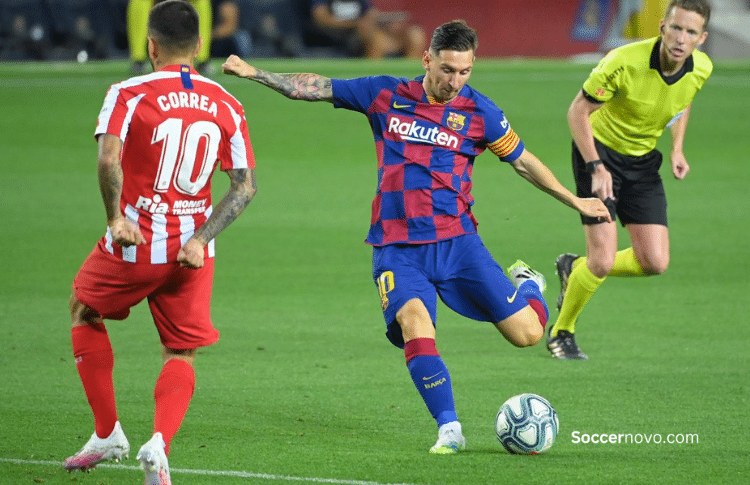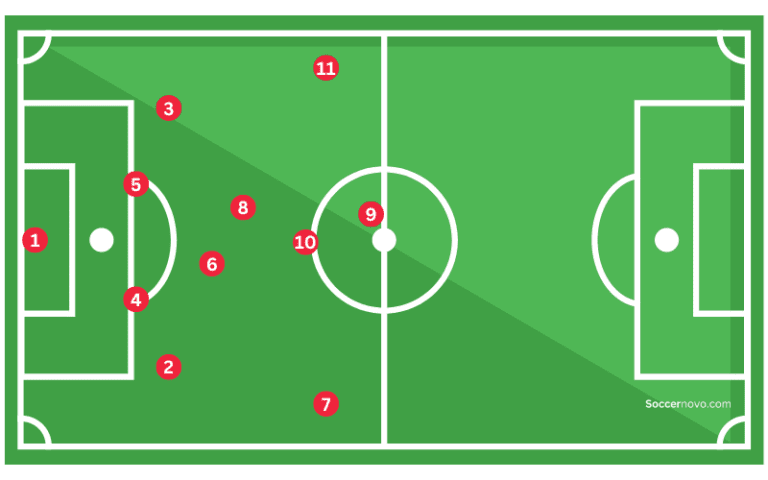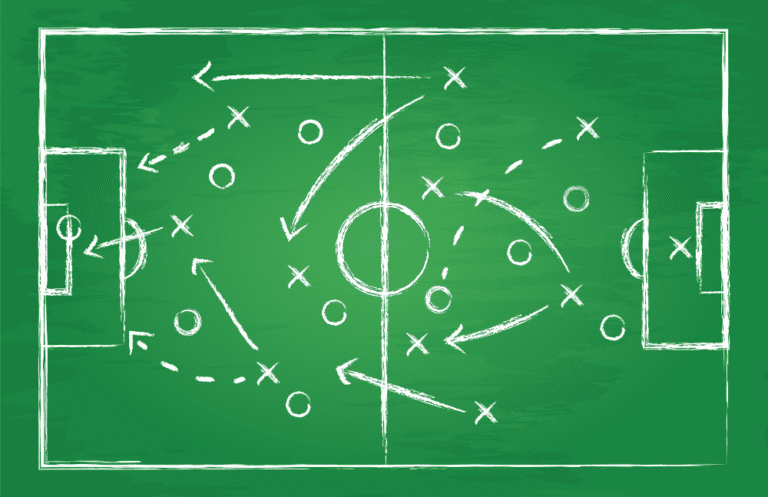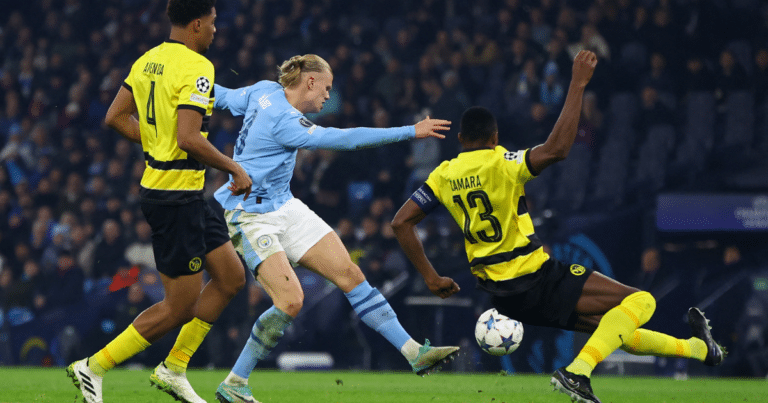What is a False 9 In Soccer?

What is a false 9 in soccer? A false 9 is essentially a midfielder in the central attacking position, who is responsible for dropping deep into midfield to create space for other players to run into.
The False 9 position is all about deception and misdirection. The player in this position is not a traditional center forward, but rather a mobile attacking midfielder who can drop deep and create chances for the team. This tactic can be particularly effective against teams that play with a high defensive line, as the false 9 can draw defenders out of position and create space for other attacking players.
 The role of a false 9 really started taking shape during mainstream soccer matches in the early 2010s.
The role of a false 9 really started taking shape during mainstream soccer matches in the early 2010s.
Lionel Messi is often credited with popularizing the false 9 role in the modern soccer game, particularly during his time at Barcelona where he played as a false 9 in a team that dominated La Liga for many years.
We’ll dig into the origins and some of the details surrounding the false 9 position in soccer.
Where Did the False 9 Come From?
The number 9 has historically been designated for the striker position.
The concept of the false 9 was first introduced in the 1930s by Austrian striker Matthias Sindelar.
Although the dropping forward was already practiced in central Europe and South America in the 1920s, Sindelar was the first to bring it to the forefront.
Due to his unconventional build, Sindelar was often forced to drop deep into the midfield to create space and involve his forwards and wingers.
In recent years, the false 9 has gained more popularity thanks to Pep Guardiola. During his coaching tenure at Barca, Guardiola’s positional theory emphasizes creating advantages between lines of pressure through well-rehearsed movements and quick passing.
He utilized this strategy by instructing the GOAT, Lionel Messi, to drop deep into the midfield and create passing options for the team.
Another case of the rise of false 9 is Luca Spaletti’s Roma in the mid-2000s. The focal point of Spaletti’s team was Francesco Totti, who served as a creative attacking midfielder with striking duties. Spaletti’s use of the false 9 sparked interest among other tacticians and the strategy became widespread in the early 2010s. By employing a false 9, teams can exploit the potential for overloads between the opposing midfield and defensive lines
What Exactly is a False 9?
In 2-3-5 formations, the number 9 occupied the central and most offensive position. Although numbers may vary on defense and midfield across different teams, number 9 is mainly used by strikers worldwide.
There are, of course, some exceptions to this rule – think of Gavi from Spain who wore number 9 during the 2022 World Cup in Qatar. Gavi is not a typical striker, yet he sometimes takes the role of a false 9.
On the other hand, the true number 9 is the player who leads the attack, either by playing close to the opposing defense or holding up the ball to bring up other players.
The purpose of playing a false 9 is to score goals, either by getting on the end of crosses or feeding off through balls.
As such, the traditional number 9 plays a central attacking role and challenges the opposing center backs to find space and opportunities to score.
Tactics and Strategies for Using a False 9
When using a false 9 in soccer, there are several tactics and strategies that you can employ to maximize the effectiveness of this position. Here are a few things to keep in mind:
1. Create Space
One of the key advantages of using a false 9 is that it can create space for other players on the field. By dropping back into midfield, the false 9 can draw defenders out of position and create gaps in the defense. This can open up opportunities for other players to make runs or take shots on goal.
2. Use Quick Passing
To take advantage of the space created by the false 9, you need to move the ball quickly. Short, sharp passes can help you move the ball up the field and create scoring opportunities. The false 9 can be particularly effective in this regard, as they are often skilled at playing one-touch passes and can quickly move the ball into dangerous areas.
3. Vary Your Attack
While the false 9 can be an effective attacking strategy, it is important to vary your approach. If you rely too heavily on the false 9, the defense may catch on and adjust their tactics accordingly. By mixing up your attack and using a variety of formations and strategies, you can keep the defense guessing and create more scoring opportunities.
4. Utilize the Wings
Another way to take advantage of the space created by the false 9 is to utilize the wings. By spreading the field and attacking from the flanks, you can create even more space in the middle and make it harder for the defense to contain your attack. The false 9 can be particularly effective in this regard, as they can draw defenders out of the middle and create opportunities for wingers to make runs and crosses.
Advantages of Using a False 9
Using a false 9 in soccer can provide several advantages to your team. Here are some of the benefits of using this tactical approach:
Creates More Space
A false 9 can create space by pulling the opposition’s center-backs out of position. This creates gaps in the defense that your team can exploit. The false 9 will drop deep into midfield, creating space for the wingers to run in behind the defense.
Confuses Defenders
A false 9 can confuse defenders by not being a traditional center forward. This makes it difficult for defenders to mark the false 9, as they are not sure who should pick them up. This confusion can create opportunities for your team to score.
Allows for More Creativity
A false 9 can allow for more creativity in attack. The false 9 can drop deep and link up with midfielders, creating passing triangles that can break down defenses. This allows for more fluid attacking play and can create more goal-scoring opportunities.
Provides Defensive Cover
A false 9 can provide defensive cover by dropping deep and helping out in midfield. This can help your team win the ball back quickly and launch counter-attacks. The false 9 can also press the opposition’s defense, forcing them into making mistakes.
Can Suit Different Player Types
A false 9 can suit different player types, as it does not require a traditional center forward. This means that players who are not natural center forwards can play in this position. For example, a creative midfielder or a winger who likes to drop deep can play as a false 9.
Disadvantages of Using a False 9
When playing with a false 9, there are several disadvantages that you should consider. Here are some of the most common ones:
Lack of Physical Presence
One of the main disadvantages of using a false 9 is the lack of physical presence in the attacking line. Since the false 9 is usually a smaller, more agile player, they may struggle to compete with taller, stronger defenders in the air. This can make it difficult to win headers and hold up the ball, which can limit your team’s attacking options.
Defensive Vulnerabilities
Another disadvantage of using a false 9 is the potential for defensive vulnerabilities. Since the false 9 tends to drop deep to receive the ball, it can leave a gap in the attacking line that can be exploited by the opposition. This can leave your team exposed to counterattacks and make it harder to defend as a unit.
Limited Goal-Scoring Opportunities
While the false 9 can be effective at creating space and opportunities for other players, it can also limit your team’s goal-scoring options. Since the false 9 tends to drop deep, they may not always be in the best position to score goals themselves. This can put more pressure on other attacking players to score, which can make it harder to convert chances into goals.
Lack of Physicality in the Box
Finally, using a false 9 can also limit your team’s physicality in the box. Since the false 9 is often smaller and more agile, they may struggle to compete with taller, stronger defenders in the penalty area. This can make it harder to score goals from crosses and set pieces, which can limit your team’s attacking options.
Famous Examples of False 9s in Soccer
When it comes to playing with a false 9, there are a few players who have become famous for their mastery of the position. Here are some of the most notable examples:
- Lionel Messi – As we previously mentioned, perhaps the most famous false 9 of all time, Messi has been known to play in this position for both Barcelona and the Argentina national team. His ability to drop deep, create space, and score goals has made him a formidable force on the pitch.
- Francesco Totti – Totti played as a false 9 for Roma in the later stages of his career. His ability to hold up the ball, create chances for his teammates, and score goals made him a fan favorite and a key player for the Italian side.
- Roberto Firmino – Firmino has been playing as a false 9 for Liverpool since 2017. His work rate, ability to press defenders, and link-up play with his teammates has made him an integral part of the team’s success in recent years.
- Thierry Henry – Although he is better known for his time as a striker, Henry played as a false 9 for Barcelona during the 2009-2010 season. His speed, skill, and vision made him a perfect fit for the position, and he helped lead the team to a La Liga title and a Champions League trophy.
- Cesc Fabregas – Fabregas played as a false 9 for Spain during their successful 2012 European Championship campaign. His ability to control the midfield and create chances for his teammates helped Spain dominate their opponents and win the tournament.
Can Anyone Play a False 9?
The false 9 position requires a player with specific skills and attributes, including offensive creativity and the ability to perform well under pressure.
Teams that are successful in utilizing the false 9 tend to dominate, while those that struggle to use it effectively struggle to score.
A typical striker, or a traditional number 9, typically possesses different qualities, such as height and physical strength, rather than creativity and the ability to orchestrate play.
The agility and precision that players like Messi play with can fit into a role of a false 9 effectively. Someone like Harry Kane may not be as effective for his team.
Conclusion
Having a coach who wants to implement a false 9 into their lineup could find success. As we mentioned earlier, not anyone can successfully play this role, and not every team is able to use their strikers as a false 9.
Having the perfect strategy in combination with a player who can actually play this role is almost always a match made in heaven.
If you are a player reading this, the skills of a false 9 are very valuable for a team. Intangible skills such as quick turns and passes, confidence to hold onto the ball for multiple seconds, offensive mindset and aggressive play are the cornerstone to a great team who can dominate in the middle.
Click on the link, if you’d like to learn more about soccer positions!

Written By: Beau Bridges
Beau is the founder of SoccerNovo, dedicated to helping players and parents navigate the youth soccer landscape. As a former youth coach and soccer parent, he shares insights on player development, recruiting, and the ever-evolving soccer scene in the U.S.
Let’s connect







